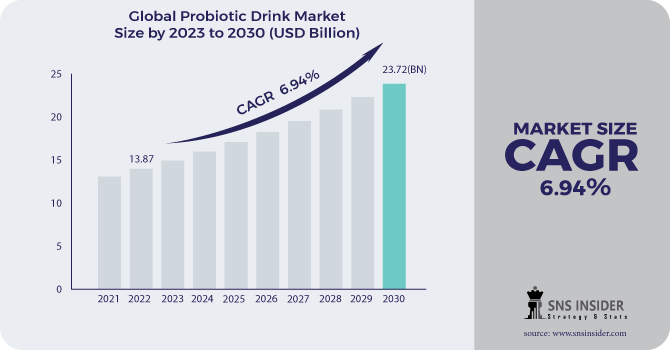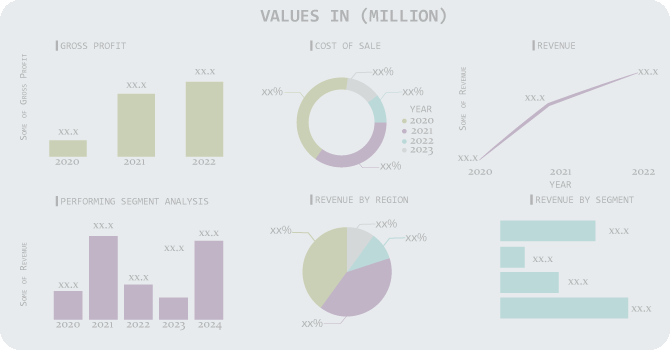Probiotic Drink Market Report Scope & Overview:
The Probiotic Drink Market Size was esteemed at USD 13.87 billion out of 2022 and is supposed to arrive at USD 23.72 billion by 2030, and develop at a CAGR of 6.94% over the forecast period 2023-2030.
Probiotics are microbes that give medical advantages when consumed. Ingested microscopic organisms that are connected with human and creature medical advantages are alluded to as probiotics. Probiotic drinks are regularly dairy-based refreshments with a smooth surface. They are consumed to help assimilation. Expansion of probiotics to whey works on its attributes and advantages altogether. Incorporation of flavors works on tangible properties of beverages while additionally expanding its timeframe of realistic usability. These variables drive interest for probiotic drinks on the lookout.

Get E-PDF Sample Report on Probiotic Drink Market - Request Sample Report
Probiotics are essential for stomach wellbeing. Probiotic drinks are a heavenly method for keeping the stomach everything looking great. Dairy-based probiotics are accessible in an assortment of structures. Non-dairy supplements are expected for lactose prejudice, vegetarianism, and inordinate cholesterol. Probiotics have as of late been made from various leafy foods. Leafy foods are high in crucial supplements, making them an ideal lattice for making probiotic drinks with the most extreme well-being benefits.
Another organization technique for Danone SA will zero in on four support points as the organization looks for like-for-like deals development of 3% to 5%. The system comes after a survey perceived Danone failed to meet expectations contrasted with its business sectors. The four support points are rebuilding Danone's seriousness in center classifications and geologies; particular extension of Danone's presence in sections, channels, and topographies; cultivating for future development roads; and portfolio pivot.
Market Dynamics:
Driving Factors:
-
Expansion in the number of wellbeing buyers.
-
Vital participants in the market are attempting to combine their situation by presenting great items and laying out organizations with notable neighborhood nutraceutical brands.
Restraining Factors:
-
The significant expense of probiotic drinks.
Opportunities:
-
The accessibility of prepared to-drink things for use in a hurry.
-
Ascend in wellbeing mindfulness among clients, especially among youthful buyers.
Challenges:
-
Ack of mindfulness among individuals, in provincial areas of agricultural nations.
Impact of Covid-19:
During the new episode of COVID-19, inferable from required terminations and limitations by pertinent administrative organizations, tasks in numerous ventures were suspended or worked with at least representatives. Nonetheless, probiotics have different gastrointestinal medical advantages and advance insusceptibility. Subsequently, the interest in probiotic drinks has expanded during the spread of COVID 19 to keep a solid insusceptible framework. It decidedly affects the business' income development. Moreover, medical advantages related to by and large wellbeing are additionally expected to fuel the worldwide income development of the market.
Product type:
The dairy-based probiotic drinks portion held a significant portion of the worldwide probiotic savors market in 2020, and this pattern is projected to go on during the figure time frame. Probiotic drinks are for the most part produced using aged milk and other dairy items.
Flavor type:
Wellbeing cognizant individuals are huge clients of probiotic drinks. These customers are more centered around the nature of items as opposed to the flavor or taste of items. In addition, probiotic drinks are made from aged milk or yogurt by further adding live Lactobacillus casei Shirota microbes to the item. Also, probiotic drinks are viewed as prepared to drink or in hurry drinks that are broadly accessible as shots. Standard probiotic drinks section driving the development of the probiotic drinks market size worldwide.
Distribution Channel:
Expansion being used of web-based business entryways in creating areas as well as an expansion in several arrangements or limits presented by these locales empower end clients, like home customers and wellbeing foundations, to purchase probiotic drinks through these stages. Moreover, internet business stages have extended client reach, bringing about it turning into a significant wellspring of income for some organizations. Moreover, attributable to a quick increment of web-empowered portable client bases in arising countries, the online business section is supposed to grow from now on.
Market Segmentation:
By Type:
-
Dairy-Based
-
Plant-Based
By Flavor:
-
Regular
-
Berry
-
Tropical
-
Others
By Sales Channel:
-
Hypermarkets And Supermarkets
-
Convenience Stores
-
Online Retail
-
Others
.png)
Get Customized Report as per Your Business Requirement - Request For Customized Report
Regional Analysis:
-
North America
-
USA
-
Canada
-
Mexico
-
-
Europe
-
Germany
-
UK
-
France
-
Italy
-
Spain
-
The Netherlands
-
Rest of Europe
-
-
Asia-Pacific
-
Japan
-
south Korea
-
China
-
India
-
Australia
-
Rest of Asia-Pacific
-
-
The Middle East & Africa
-
Israel
-
UAE
-
South Africa
-
Rest of Middle East & Africa
-
-
Latin America
-
Brazil
-
Argentina
-
Rest of Latin America
-
Asia-Pacific has been ruling the probiotic drinks piece of the pie and is supposed to support its strength during the figure time frame. Both on the web and disconnected interest for probiotic drinks is developing, which has additionally advanced the development of the territorial market. The most encouraging development rate in this course is supposed to come from Asia-Pacific. The solid development of the provincial market is ascribed to the quick improvement of the well-being and health industry in the district.
Key Players:
GCMMF (AMUL), Fonterra Co-operative Group Ltd, Yakult Honsha Co., Ltd., Denone SA, Bio-K+, Lifeway Foods, Inc., Chobani, LLC, NextFoods, Inc., PepsiCo Inc, and Harmless Harvest.
NextFoods, Inc-Company Financial Analysis

| Report Attributes | Details |
|---|---|
| Market Size in 2022 | US$ 13.87 Billion |
| Market Size by 2030 | US$ 20.75 Billion |
| CAGR | CAGR 6.94% From 2023 to 2030 |
| Base Year | 2022 |
| Forecast Period | 2023-2030 |
| Historical Data | 2020-2021 |
| Report Scope & Coverage | Market Size, Segments Analysis, Competitive Landscape, Regional Analysis, DROC & SWOT Analysis, Forecast Outlook |
| Key Segments | • by Type (Dairy-Based, Plant-Based) • by Flavor (Regular, Berry, Tropical, Others) • by Sales Channel (Hypermarkets and Supermarkets, Convenience Stores, Online Retail, Others) |
| Regional Analysis/Coverage | North America (USA, Canada, Mexico), Europe (Germany, UK, France, Italy, Spain, Netherlands, Rest of Europe), Asia-Pacific (Japan, South Korea, China, India, Australia, Rest of Asia-Pacific), The Middle East & Africa (Israel, +D11UAE, South Africa, Rest of Middle East & Africa), Latin America (Brazil, Argentina, Rest of Latin America) |
| Company Profiles | GCMMF (AMUL), Fonterra Co-operative Group Ltd, Yakult Honsha Co., Ltd., Denone SA, Bio-K+, Lifeway Foods, Inc., Chobani, LLC, NextFoods, Inc., PepsiCo Inc, and Harmless Harvest. |
| Drivers | •Expansion in the number of wellbeing cognizant buyers. |
| Market Opportunities | •The accessibility of prepared to-drink things for use in a hurry. •Ascend in wellbeing mindfulness among clients, especially among youthful buyers. |

